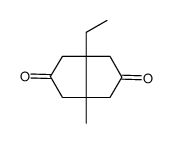600-14-6
| 中文名 | 2,3-戊二酮 |
|---|---|
| 英文名 | pentane-2,3-dione |
| 中文别名 |
乙酰基丙酰
乙酰丙酰 2,3-戊烷二酮 |
| 英文别名 |
EINECS 209-984-8
MFCD08443597 2,3-Pentadione 2.6-Pentanedione 2,3-PENTANEDITHIOL 3,4-Pentanedione ethyl methyl diketone 2VV1 PENTANDION-2,3 Acethylpropionyl pentanedione 2.3-pentanedione 2,3-pentandione Acetylpropionyl 2,3-Pentandion 2,3-Pentanedione |
| 描述 | 2,3-Pentanedione 是合成香料的一种常见成分,用于在饮料、冰淇淋、糖果、烘焙食品、明胶和布丁中提供黄油、草莓、焦糖、水果、朗姆酒或奶酪的香味。2,3-Pentanedione 也作为发酵产物自然存在于啤酒、葡萄酒和酸奶中,并在咖啡豆烘焙过程中释放。 |
|---|---|
| 相关类别 | |
| 参考文献 |
| 密度 | 1.0±0.1 g/cm3 |
|---|---|
| 沸点 | 108.0±0.0 °C at 760 mmHg |
| 熔点 | -52 °C |
| 分子式 | C5H8O2 |
| 分子量 | 100.116 |
| 闪点 | 18.9±0.0 °C |
| 精确质量 | 100.052429 |
| PSA | 34.14000 |
| LogP | -0.80 |
| 外观性状 | 透明至黄色液体 |
| 蒸汽压 | 26.4±0.2 mmHg at 25°C |
| 折射率 | 1.395 |
| 储存条件 | 贮存: 将密器密封,储存密封的主藏器内,并放在阴凉, 干爽的位置。 |
| 稳定性 | 1.性质与稳定性:常温常压下,或不分解产物。 2.黄色液体。广泛存在于多种食品中家禽、家畜奶乳、焙烤类坚果炸土豆、面包、浆果番茄,饮料的可可、茶叶,酒精饮料中啤酒各种洋酒都有此成分存在,某些精油也发现其存在,该化合物为丁二酮的类似系列产品,乳脂奶香为其主要特有风格,溶于水中,又有微甜的味道。 3. 存在于主流烟气中。 |
| 水溶解性 | 60 g/L (15 ºC) |
| 分子结构 | 五、分子性质数据: 1、 摩尔折射率:25.27 2、 摩尔体积(cm3/mol):105.4 3、 等张比容(90.2K):241.2 4、 表面张力(dyne/cm):27.5 5、 极化率(10-24cm3):10.01 |
| 计算化学 | 1.疏水参数计算参考值(XlogP):0.1 2.氢键供体数量:0 3.氢键受体数量:2 4.可旋转化学键数量:2 5.互变异构体数量:8 6.拓扑分子极性表面积34.1 7.重原子数量:7 8.表面电荷:0 9.复杂度:94.3 10.同位素原子数量:0 11.确定原子立构中心数量:0 12.不确定原子立构中心数量:0 13.确定化学键立构中心数量:0 14.不确定化学键立构中心数量:0 15.共价键单元数量:1 |
| 更多 | 1.性状:黄色或带黄绿色清澈液体
2.熔点(℃):-52 3.沸点(℃):108 4. 溶解性:溶于水、乙醇、乙醚、丙酮。 5.常温折射率(n19D) :1.4014 6.相对密度(20℃,4℃):0.9565 7. 闪点(ºC):18 |
Synonym:Acetylpropiony Section 2 - COMPOSITION, INFORMATION ON INGREDIENTS
Risk Phrases: 11 Section 3 - HAZARDS IDENTIFICATION EMERGENCY OVERVIEW
Highly flammable. Potential Health Effects Eye: May cause eye irritation and possible burns. Skin: Causes skin irritation and possible burns. Ingestion: May cause digestive tract disturbances. Inhalation: May cause respiratory tract irritation. Vapors may cause dizziness or suffocation. Chronic: No information found. Section 4 - FIRST AID MEASURES Eyes: Flush eyes with plenty of water for at least 15 minutes, occasionally lifting the upper and lower eyelids. Get medical aid immediately. Skin: Get medical aid. Flush skin with plenty of water for at least 15 minutes while removing contaminated clothing and shoes. Remove contaminated clothing and shoes. Ingestion: If victim is conscious and alert, give 2-4 cupfuls of milk or water. Never give anything by mouth to an unconscious person. Get medical aid immediately. Inhalation: Remove from exposure and move to fresh air immediately. If not breathing, give artificial respiration. If breathing is difficult, give oxygen. Get medical aid. Notes to Physician: Section 5 - FIRE FIGHTING MEASURES General Information: As in any fire, wear a self-contained breathing apparatus in pressure-demand, MSHA/NIOSH (approved or equivalent), and full protective gear. Vapors may form an explosive mixture with air. Vapors can travel to a source of ignition and flash back. During a fire, irritating and highly toxic gases may be generated by thermal decomposition or combustion. Will burn if involved in a fire. Use water spray to keep fire-exposed containers cool. Containers may explode in the heat of a fire. Flammable liquid and vapor. Vapors may be heavier than air. They can spread along the ground and collect in low or confined areas. Extinguishing Media: For small fires, use dry chemical, carbon dioxide, water spray or alcohol-resistant foam. For large fires, use water spray, fog, or alcohol-resistant foam. Water may be ineffective. Do NOT use straight streams of water. Cool containers with flooding quantities of water until well after fire is out. Section 6 - ACCIDENTAL RELEASE MEASURES General Information: Use proper personal protective equipment as indicated in Section 8. Spills/Leaks: Absorb spill with inert material (e.g. vermiculite, sand or earth), then place in suitable container. Avoid runoff into storm sewers and ditches which lead to waterways. Clean up spills immediately, observing precautions in the Protective Equipment section. Remove all sources of ignition. Use a spark-proof tool. Provide ventilation. A vapor suppressing foam may be used to reduce vapors. Water spray may reduce vapor but may not prevent ignition in closed spaces. Section 7 - HANDLING and STORAGE Handling: Wash thoroughly after handling. Use with adequate ventilation. Ground and bond containers when transferring material. Use spark-proof tools and explosion proof equipment. Avoid contact with eyes, skin, and clothing. Empty containers retain product residue, (liquid and/or vapor), and can be dangerous. Keep away from heat, sparks and flame. Avoid ingestion and inhalation. Do not pressurize, cut, weld, braze, solder, drill, grind, or expose empty containers to heat, sparks or open flames. Storage: Keep away from heat, sparks, and flame. Keep away from sources of ignition. Store in a cool, dry, well-ventilated area away from incompatible substances. Refrigerator/flammables. Keep containers tightly closed. Section 8 - EXPOSURE CONTROLS, PERSONAL PROTECTION Engineering Controls: Use adequate ventilation to keep airborne concentrations low. Exposure Limits CAS# 600-14-6: Personal Protective Equipment Eyes: Wear appropriate protective eyeglasses or chemical safety goggles as described by OSHA's eye and face protection regulations in 29 CFR 1910.133 or European Standard EN166. Skin: Wear appropriate protective gloves to prevent skin exposure. Clothing: Wear appropriate protective clothing to prevent skin exposure. Respirators: Follow the OSHA respirator regulations found in 29 CFR 1910.134 or European Standard EN 149. Use a NIOSH/MSHA or European Standard EN 149 approved respirator if exposure limits are exceeded or if irritation or other symptoms are experienced. Section 9 - PHYSICAL AND CHEMICAL PROPERTIES Physical State: Liquid Color: clear yellow Odor: None reported. pH: Not available. Vapor Pressure: Not available. Viscosity: Not available. Boiling Point: 110.0 - 112.0 deg C Freezing/Melting Point: -52 deg C Autoignition Temperature: Not available. Flash Point: 18 deg C ( 64.40 deg F) Explosion Limits, lower: Not available. Explosion Limits, upper: Not available. Decomposition Temperature: Solubility in water: partially soluble Specific Gravity/Density: .9570g/cm3 Molecular Formula: C5H8O2 Molecular Weight: 100.12 Section 10 - STABILITY AND REACTIVITY Chemical Stability: Stable under normal temperatures and pressures. Conditions to Avoid: Incompatible materials, ignition sources, excess heat, strong oxidants. Incompatibilities with Other Materials: Strong oxidizing agents. Hazardous Decomposition Products: Carbon monoxide, carbon dioxide, acrid smoke and fumes. Hazardous Polymerization: Has not been reported. Section 11 - TOXICOLOGICAL INFORMATION RTECS#: CAS# 600-14-6: SA1850000 LD50/LC50: CAS# 600-14-6: Draize test, rabbit, skin: 500 mg/24H Moderate; Oral, rat: LD50 = 3 gm/kg; Skin, rabbit: LD50 = >2500 mg/kg. Skin, Rabbitt:LD50 = >2500 Carcinogenicity: 2,3-Pentanedione - Not listed by ACGIH, IARC, or NTP. Other: See actual entry in RTECS for complete information. Section 12 - ECOLOGICAL INFORMATION Section 13 - DISPOSAL CONSIDERATIONS Dispose of in a manner consistent with federal, state, and local regulations. Section 14 - TRANSPORT INFORMATION IATA Shipping Name: FLAMMABLE LIQUID, N.O.S.* Hazard Class: 3 UN Number: 1993 Packing Group: II IMO Shipping Name: FLAMMABLE LIQUID, N.O.S. Hazard Class: 3.2 UN Number: 1993 Packing Group: II RID/ADR Shipping Name: FLAMMABLE LIQUID, N.O.S. Hazard Class: 3 UN Number: 1993 Packing group: II Section 15 - REGULATORY INFORMATION European/International Regulations European Labeling in Accordance with EC Directives Hazard Symbols: F Risk Phrases: R 11 Highly flammable. Safety Phrases: S 9 Keep container in a well-ventilated place. S 16 Keep away from sources of ignition - No smoking. S 33 Take precautionary measures against static discharges. S 50A Do not mix with acids. WGK (Water Danger/Protection) CAS# 600-14-6: 1 Canada CAS# 600-14-6 is listed on Canada's DSL List. CAS# 600-14-6 is not listed on Canada's Ingredient Disclosure List. US FEDERAL TSCA CAS# 600-14-6 is listed on the TSCA inventory. SECTION 16 - ADDITIONAL INFORMATION N/A |
|
毒理学数据: 大鼠急性经口LD50:2.6~3.4g/kg,兔子经皮LD50>2.5g/kg。在闭合条件下,样品抹在兔子皮肤上1日,发现有中等刺激现象。其4%的凡士林制剂作人体封闭性皮肤接触试验,未发现产品刺激现象和致敏作用。 急性毒性: 口腔 LD50 3000mg/kg(rat) 皮肤LD50 >2500mg/kg(rbt) 刺激皮肤 moderate 500mg/24H(rbt) 主要的刺激性影响: 在皮肤上面:刺激皮肤和黏膜。 在眼睛上面:刺激的影响。 致敏作用:没有已知的敏化作用。 生态学数据: 三、生态学数据: 总括注解 水危害级别1(德国规例)(通过名单进行自我评估)该物质对水有稍微危害的。 不要让未稀释或大量的产品接触地下水、水道或污水系统。 若无政府许可,勿将材料排入周围环境。 CHEMICAL IDENTIFICATION
HEALTH HAZARD DATAACUTE TOXICITY DATA
|
| 符号 |


GHS02, GHS07 |
|---|---|
| 信号词 | Danger |
| 危害声明 | H225-H315-H319-H335 |
| 警示性声明 | P210-P261-P305 + P351 + P338 |
| 个人防护装备 | Eyeshields;Faceshields;full-face respirator (US);Gloves;multi-purpose combination respirator cartridge (US);type ABEK (EN14387) respirator filter |
| 危害码 (欧洲) | F:Flammable |
| 风险声明 (欧洲) | R11;R36/37/38 |
| 安全声明 (欧洲) | S16-S26-S36-S37/39 |
| 危险品运输编码 | UN 1224 3/PG 2 |
| WGK德国 | 1 |
| RTECS号 | SA1850000 |
| 包装等级 | II |
| 危险类别 | 3 |
| 海关编码 | 2914190090 |
| 上游产品 7 | |
|---|---|
| 下游产品 10 | |
| 海关编码 | 2914190090 |
|---|---|
| 中文概述 | 2914190090 其他不含其他含氧基的无环酮。监管条件:无。增值税率:17.0%。退税率:9.0%。最惠国关税:5.5%。普通关税:30.0% |
| 申报要素 | 品名, 成分含量, 用途, 丙酮报明包装 |
| Summary | 2914190090 other acyclic ketones without other oxygen function。Supervision conditions:None。VAT:17.0%。Tax rebate rate:9.0%。MFN tariff:5.5%。General tariff:30.0% |


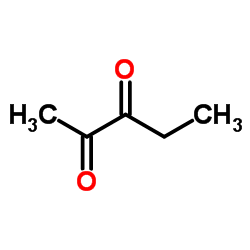



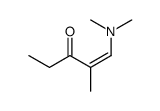


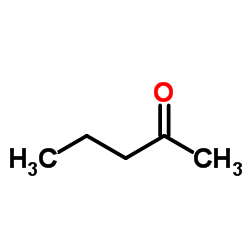
![2-[(E)-[(2Z)-2-(diaminomethylidenehydrazinylidene)pentan-3-ylidene]amino]guanidine结构式](https://image.chemsrc.com/caspic/295/106119-98-6.png)





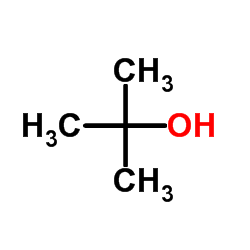
![[(Z)-[(2E)-2-(carbamothioylhydrazinylidene)pentan-3-ylidene]amino]thiourea结构式](https://image.chemsrc.com/caspic/301/18667-57-7.png)
